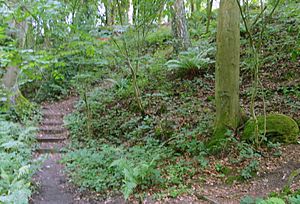CS Lewis Nature Reserve facts for kids
Quick facts for kids CS Lewis Nature Reserve |
|
|---|---|
 |
|
| Type | Nature reserve |
| Location | Risinghurst, Oxfordshire |
| OS grid | SP 560067 |
| Area | 3 hectares (7.4 acres) |
| Managed by | Berkshire, Buckinghamshire and Oxfordshire Wildlife Trust |
The CS Lewis Nature Reserve is a special place covering about 3 hectares (or 7.4 acres) in Risinghurst, a part of Oxford in Oxfordshire. It's a nature reserve, which means it's a protected area where plants and animals can live safely. The reserve is looked after by the Berkshire, Buckinghamshire and Oxfordshire Wildlife Trust, a group dedicated to protecting wildlife and wild places.
This peaceful reserve used to belong to a famous writer of children's books, C. S. Lewis. It features a unique flooded clay pit, which is like a small pond. This pond is home to many different water plants, toads, and beautiful insects like dragonflies and damselflies. The reserve also has a steeply sloped woodland area filled with large, interesting boulders. It's a wonderful spot to explore nature and imagine stories, just like C.S. Lewis might have done!
Contents
Discovering the CS Lewis Nature Reserve
The CS Lewis Nature Reserve is a hidden gem in Oxford. It offers a quiet escape where you can connect with nature. This small but mighty reserve is a great example of how important it is to protect natural spaces, even in busy areas. It provides a home for many creatures and a peaceful spot for people to visit.
Who was C.S. Lewis?
Clive Staples Lewis, known as C.S. Lewis, was a very famous British writer. He lived from 1898 to 1966. He taught at Oxford University and later at Cambridge University. Lewis is best known for his amazing fantasy series, The Chronicles of Narnia. These books, like The Lion, the Witch and the Wardrobe, have enchanted millions of readers around the world. He also wrote many other books for adults, including science fiction and Christian writings.
Lewis owned the land that is now the nature reserve. It's thought that the wild beauty of this place might have even inspired some of his magical stories. Imagine him walking through the woods, thinking up new adventures for Lucy, Edmund, Susan, and Peter!
What Makes the Reserve Special?
The CS Lewis Nature Reserve is special because it has different types of habitats in one small area. A habitat is a natural home for plants and animals. Here, you can find a mix of woodland and wetland environments.
The Flooded Clay Pit
One of the main features is the flooded clay pit. This pit was created when clay was dug out of the ground a long time ago. Now, it's filled with water and has become a thriving pond. You can spot many types of aquatic plants growing in and around the water. This watery habitat is perfect for amphibians like toads, which lay their eggs here. It's also a fantastic place to see dragonflies and damselflies. These insects are known for their bright colors and amazing flying skills. They spend part of their lives as nymphs in the water before transforming into winged adults.
The Woodland Area
Beyond the pond, there's a woodland area that slopes quite steeply. This part of the reserve is filled with trees and large boulders. Woodlands provide shelter and food for many different animals, including birds, small mammals, and insects. Walking through the woods, you might hear birds singing or see squirrels scampering up trees. The large boulders add to the unique feel of the place, making it an interesting spot to explore.
Protecting Nature for the Future
The Berkshire, Buckinghamshire and Oxfordshire Wildlife Trust manages the CS Lewis Nature Reserve. Their job is to make sure the reserve stays a safe and healthy place for wildlife. They work to protect the habitats and the species that live there. This includes looking after the water quality in the clay pit and managing the trees in the woodland.
By visiting places like the CS Lewis Nature Reserve, we can learn more about the natural world around us. It reminds us how important it is to conserve these spaces for future generations. Protecting nature helps keep our planet healthy and provides beautiful places for everyone to enjoy.

